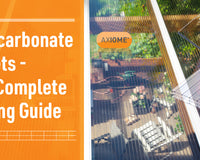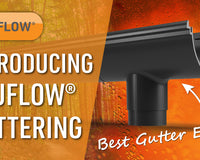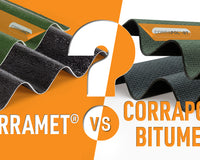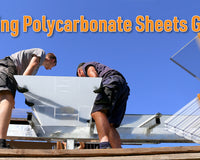Struggling to find the correct greenhouse polycarbonate sheets to use? After reading this article you will be able to choose the best polycarbonate sheets for your greenhouse with ease.
Whether you are installing a greenhouse from scratch or replacing greenhouse panels it can be confusing understanding the different plastic sheet options and weighing up which is best to ensure your greenhouse can fully function to grow vegetables and fruit for your family to enjoy.
You may or may not know already the there are two types of polycarbonate sheets that you can use for your greenhouse: solid polycarbonate and twin wall polycarbonate. They have similar properties, such as great clarity, however, they vary in thickness, impact resistance and pricing which we will explain further.
Before exploring the differences between these two types of polycarbonate in further detail, let’s understand why polycarbonate sheets for greenhouses are chosen in the first place.
Why is polycarbonate good for greenhouses?
Polycarbonate has many benefits for use on greenhouses. It's a lot more durable than greenhouse glass and lasts years longer. Polycarbonate sheets are shatterproof so won’t crack or smash like glass panes. This eliminates any accidents happening to your greenhouse.
The other major benefit of using polycarbonate is how easy it is to install, especially compared to glass. Both types of polycarbonate sheets can be cut to size using a fine-toothed blade. When installing this weight saving is a massive benefit that makes handling and securing polycarbonate sheets straightforward.
Did you know that solid polycarbonate is half the weight of glass and twinwall polycarbonate is ten times lighter?
Light transmission is how much light is let through by the sheet. Clear polycarbonate has a high light transmission which allows maximum brightness. It allows your greenhouse to be a bright airy space which is essential as generally speaking greenhouses ideally require six hours of direct sunlight each day. Axiome® Twin wall has a high light transmission of approximately 81%, which provides excellent clarity. It is also worth noting the twinwall polycarbonate blocks harmful UV radiation, which is a major benefit when working inside.
Finally, Polycarbonate has great thermal insulation qualities; it naturally retains heat fantastically which is just what you need when it comes to a greenhouse.
Please be aware that not all polycarbonate greenhouse glazing is manufactured to the same quality, with some sheets lacking UV protection or quality clear clarity, so always use reputable brands like Axiome® or Axgard®.
What is the best type of polycarbonate for a greenhouse?
The two types of polycarbonate sheets for greenhouses are Twinwall Polycarbonate and Solid Polycarbonate. Both are great options with similar qualities but ultimately, Solid Polycarbonate sheets are the better choice for strength and style reasons – we’ll now explain why.
Twinwall is a polycarbonate sheet that is made up of two layers with a structure in between. Being structured these sheets are a lightweight option. A solid sheet on the other hand is a plastic sheet that looks like glass, being solid polycarbonate all the way through. This structural difference means that if appearance is a big factor for you typically the solid polycarbonate glazing sheet with its ‘glass look’ is going to look better in your garden and is considered a more traditional style.
Beyond appearance, there are three points of difference between Solid & Twinwall greenhouse polycarbonate:
- Impact Strength
- Cost
- Light Transmission & Clarity

1. Impact Strength of Solid versus Twinwall Polycarbonate
Twinwall polycarbonate is a lightweight sheet however it also has a good impact strength when compared to glass. Its impact strength is due to it having multiple layers, meaning it spreads any impact throughout the layers.
If you're looking for the highest impact strength sheet then Solid polycarbonate sheets are the best option. They give a higher impact strength than any other plastic sheet and are often described as virtually unbreakable. It is an incredible 200 times stronger than glass of the same thicker due to the polymer resin it is manufactured from.
On impact resistance, the solid glazing sheets are definitely the better option.
2. Cost difference between solid and twinwall polycarbonate?
Twinwall polycarbonate is the more cost-effective option for anyone on a budget. Although it does still have great features compared to solid sheets it’s the more budget option. Primarily this is because it isn’t solid so there is less raw material used per metre. If you choose twinwall it is worth spending that extra money on a thicker thickness, like the 10mm polycarbonate sheet or thicker, to ensure good strength.
Solid polycarbonate is considered a more premium option for a greenhouse. As with anything, better quality comes with a bigger cost, however, for many people the extra strength and visual quality that solid polycarbonate offers far outweighs the extra money spent.
Overall, Twinwall is a cheaper greenhouse polycarbonate option and solid the more expensive, but not without good reason. Work to what suits your budget but to do the best job possible for your greenhouse we suggest that solid plastic is worth the extra outlay initially.
3. Is solid greenhouse polycarbonate or twin wall polycarbonate clearer?
Both varieties of greenhouse polycarbonate sheets are manufactured in clear options. However, Solid polycarbonate offers a higher light transmission of over 90% compared to the 81% offered by twinwall. This does not mean that twinwall polycarbonate will cast a shadow but simply that solid reduces the light level less!
Along with better light transmission, solid polycarbonate has a lot greater clarity meaning if you are looking for polycarbonate panels for maximum light in your greenhouse solid is the way to go
How thick should polycarbonate be for a greenhouse?
Polycarbonate is an excellent choice for greenhouses due to its robustness, so what thickness is the best?
Well, this does depend on the individual's own needs and specific uses. The frame can also have an impact on the thickness if you are not building from scratch.
When choosing the thickness of polycarbonate sheets for your greenhouse it depends if you are using solid or twinwall sheets. We recommend 6mm or 10mm for twinwall polycarbonate sheets and between 3mm-6mm for solid glazing sheets.
The most common thickness for greenhouses with solid polycarbonate panels is 6mm. This means it's suitable for any type of weather. 6mm thickness is an excellent choice, as it offers a good mix of strength and cost-effectiveness. It has a very high impact strength and a good level of rigidity, meaning there is very little chance of damage occurring.
Another important factor to take into consideration is if you are replacing a greenhouse panel 6mm glass would have most commonly been used before so a matching thickness polycarbonate panel means the installation is a simple swap over. It saves time, money, and hassle which means you can get on with the stuff that matters most to you, growing what's inside the greenhouse.
If you decide that twin-wall polycarbonate is for you, then it is always worth spending the extra money on a thicker sheet for maximum support. Although the cost may be a slight increase it will benefit you in the long run and equally, save you money replacing panels. 10mm is a great thickness to choose from as it provides greater insulation and strength. Relatively speaking 4mm twin-wall is not recommended as it's quite flimsy and will easily blow out during storms or strong gusts of winds. Meaning in the long run, it will cost you more money to replace these.
What colour of Greenhouse Polycarbonate is best?
Light is a crucial factor when it comes to growing in your greenhouse. The light will affect the growth of your plants so it's important to get the colour right when choosing your panels.
Clear is naturally the most popular greenhouse polycarbonate sheet colour as it offers maximum light transmission and transparency. Plants, fruit, and vegetables all require significant light to grow so it only makes sense to use clear sheeting.
You might find that once you're in the full swing of using your greenhouse some plants that you are growing will require less light than others. There is a simple solution to this. Swapping in a few Opal Polycarbonate sheet panels for shading at one of the ends, allows you to get the best use out of your greenhouse. There is also bronze polycarbonate sheet however this is not used for greenhouses as often compared to clear and opal. It is still an option though depending on your needs for the greenhouses!
Remember you can always replace your panels easily if you choose the same thickness!
What is the best greenhouse polycarbonate to use?
In our opinion, a solid glazing sheet is the ultimate greenhouse polycarbonate sheet to use. It has the best appearance in terms of keeping the 'traditional greenhouse' look. They have the best light transmission and although it is the more premium option it's worth spending the extra money to create your ultimate greenhouse.
There are advantages and disadvantages to using solid and twin wall panels for your greenhouse. When it comes to your greenhouse design it is dependent on the individual and their specific preferences. Clear is the best colour to use however some panels can be changed to provide shade in some areas depending on what you're growing.
As discussed, both sheet types have excellent light transmission and easy installation which make them both ideal for a greenhouse. If you are on a budget twin wall is recommended however it's best to go 10mm thick as anything below, such as 4mm, is flimsy so most likely will not hold up in poor weather conditions or strong winds.
Bonus Greenhouse Polycarbonate Question
How to stop polycarbonate greenhouse panels from blowing out?
Our typical UK weather of strong winds and storms can cause greenhouse panels to blow out however there are a few options that you can try to eliminate the risk of this happening to your greenhouse.
If your greenhouse is not yet installed, then we would suggest considering a sheltered location in your garden. Just make sure you have around 1 meter of space around the entire perimeter. This will allow cleaning and replacing panels easier. It's also worth avoiding placing your greenhouse directly underneath tall trees as this will reduce your sunlight and cause grime to build up on the outside fast.
Once your frame is there are ways to strength the installing, including using a clear silicone sealant around the frame. This will bond the sheet to the frame in addition to the existing frame, essentially making it more secure and preventing any damage. Alternatively, by installing new glazing bars to properly secure your sheets you could stop them blowing out at all.
However, the best way to reduce panels blowing out and save you the hassle would be to replace or install your greenhouse with a stronger thickness of polycarbonate sheeting. For example, 10mm would be the best thickness to prevent any blowouts.
Need Help with Polycarbonate Sheets for your Greenhouse?
If you are needing help building quote for your polycarbonate greenhouse sheets please get in touch. Our Team will be happy to assist on our Live Chat or you can email shop@clearamber.com where our we will provide you with all the advice and support you require for your project.
Place Your Order Today – Get Same Day Despatch, Free Returns & Flexible Payment!















6 comments
Anonymous
Thanks Pam, sounds like a great plan. You would be best to use twinwall polycarbonate as it has great insulation properties. Solid polycarbonate is best for warmer climates. Doors can be created with a polycarbonate panel onto a timber door frame. Using decking for flooring is a good idea and aluminium decking is a great option. Trust that helps
Pam Allen
I am considering taking an existing pergola on my deck and repurposing it into a greenhouse. Structure is wood frame. Planning to enclose it with the 10mm poly..lication is northeast Ohio. What is diff between a solid or twin wall polycarbonate? Any tips on ventilation, door and flooring?
Anonymous
Yes, our clear 10mm clear polycarbonate sheet to that size would be 1400mm x 2500mm or we can cut to size for you. Please see the link below. Axiome Polycarbonate is easy to cut and drill, view our How 2 video. You are best to use Snapa Glazing Bars to fix to your frame.
https://clearambershop.com/products/axiome-clear-10mm-twinwall-polycarbonate-roofing-sheet
Rod
Can I buy 10mm 4ft x 8ft sheets?
I am putting the sheets on an existing wood frame with roof and wall stud spacing on 2ft centers. I need a T shaped gasket for between the sheets . Can you help me with finding this?
Can the sheets be cut with a skill saw and drilled easily?
What kind of screws should I use for attaching the sheets to my wood frame structure?
Anonymous
Good question Sandy, best to let them dry out first otherwise you may trap the moisture completely inside. Worth reading our blog about condensation inside polycarbonate sheets for more info.
Sandy
I have the twine wall sheets, but I noticed water build up is in the walls, do I have to let it dry out before I silicone the panels or will it disappear after time.